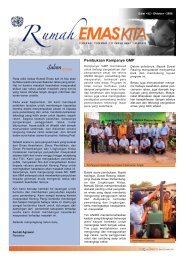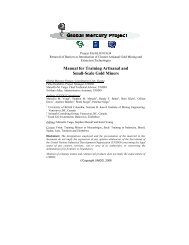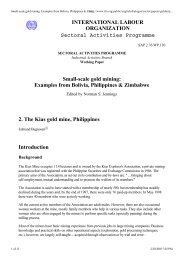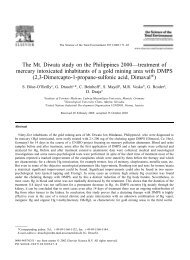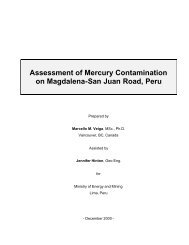ARTISANAL AND SMALL-SCALE GOLD MINES IN BURKINA FASO ...
ARTISANAL AND SMALL-SCALE GOLD MINES IN BURKINA FASO ...
ARTISANAL AND SMALL-SCALE GOLD MINES IN BURKINA FASO ...
Create successful ePaper yourself
Turn your PDF publications into a flip-book with our unique Google optimized e-Paper software.
F = PrD/PrR = PrD/[(Rtτ1 × Efτ1 × T1 × TRC1) +… …+ (RtτN × EfτN × TN × TRCN)]<br />
F: Fraudulent part of production (%)<br />
PrD: Declared gold production (g/d)<br />
PrR: Real gold production (g/d)<br />
Rtτ1…. RtτN: Average productivity for a task of processing cycles 1… to N (t/h/d)<br />
Efτ1…. EfτN: Manpower for a task of processing cycles 1… to N (h)<br />
T1…. TN: Grades of ore or waste at the start of processing cycles 1… to N (g/t Au)<br />
TRC1…. TRCN: Gold-recovery rate for processing cycles 1 to N (%)<br />
Our studies on five reference sites show that the official purchasing channels (CBMP or private) rarely<br />
collect more than 20% of the gold produced on a site. In 2002, because of insufficient human or material<br />
means, the CBMP estimated to be incapable of recovering more than 3 to 5% of the production in some<br />
districts, such as Bagassi (near Boromo) and Kampti in Lobi country. Based on these data, the fraudulent<br />
part of gold production in Burkina Faso is estimated to be close to 90%. For an official artisanal production<br />
of 250 kg/year, the real production would thus be between 2 and 2.5 tons/year. This clandestine gold<br />
represents a loss of earnings of about CFA 100 million/year (€ 0.15 million/year).<br />
for the State and the provinces, through the Artisanal Gold Mining tax alone. The full loss of income,<br />
counting all taxes, for the State probably exceeds CFA 1 billion/year (€ 1.5 million/year).<br />
Experience has shown that the systematic control of gold-producing sites is an expensive and not always<br />
efficient proposition for the authorities. To be effective, it should be accompanied by a reduction in the<br />
difference between official and unofficial gold prices. This reduction in the mark-ups of middlemen<br />
(officially appointed collectors and purchasing centres) should then be largely compensated by an increase<br />
in the volume of transactions.<br />
MAJOR SOCIAL <strong>AND</strong> MICRO-ECONOMIC IMPACT<br />
A few figures will suffice for making a concrete evaluation of the local economic and social impact of<br />
artisanal gold mining. For instance, each day at Alga (April 2002 figures):<br />
- 17 tons of ore are mined and processed to produce 420 grams of raw gold.<br />
- 1,750 miners and labourers work for an average salary of CFA 1,225/day (€ 1,85/day), including 700<br />
women who work for an average salary of CFA 640/day (€ 0,98/day).<br />
- CFA 2 million (€ 3,055) are distributed within a radius of about 40 km around the site, or about CFA<br />
25/day/inhabitant (total population).<br />
By simply extrapolating the probably real gold production figures of the country (i.e. 2 to 2.5 tons of<br />
gold per year), it is not unreasonable to assume that, in past years, during each season of artisanal gold<br />
mining in the Burkina countryside, close to CFA 10 billion (€ 15 millions) was injected into the local<br />
economy, in addition to regular agricultural income. In the country, an average of 64% of the total wealth<br />
generated by artisanal gold mining is directly redistributed to local “pit-side” producers. Gold is thus a<br />
relatively “fair” (sensu “fair trade”) commodity for the artisans when compared to gemstones. This is<br />
partly explained by the moderate operating costs and mark-ups of commercial channels (collectors and<br />
purchasing centres).<br />
A rush of opportunistic shopkeepers generally follows close upon the heels of that of the gold miners.<br />
All is thus ready on the larger sites to catch the artisan’s money: cold beer, video shows, “escort girls”,<br />
watches and cassette players. In 2002, at Nagrigré (the first rush of Zoundwéogo Province), only three<br />
months after the discovery of the vein, almost 500 —mostly regional— shopkeepers were pressing around<br />
the 2,000 artisan gold miners of the site, or one shopkeeper for four producers. At the same time, the rest of<br />
Gomboussougou Province was faced with a severe shortage of basic services, such as smiths, millers,<br />
cooks, butchers and transporters.<br />
7



